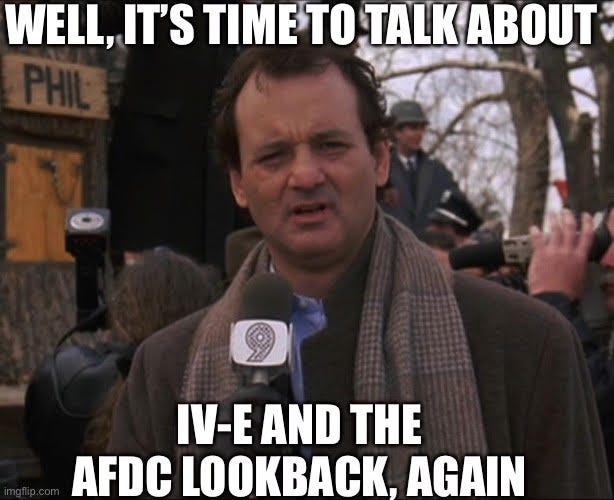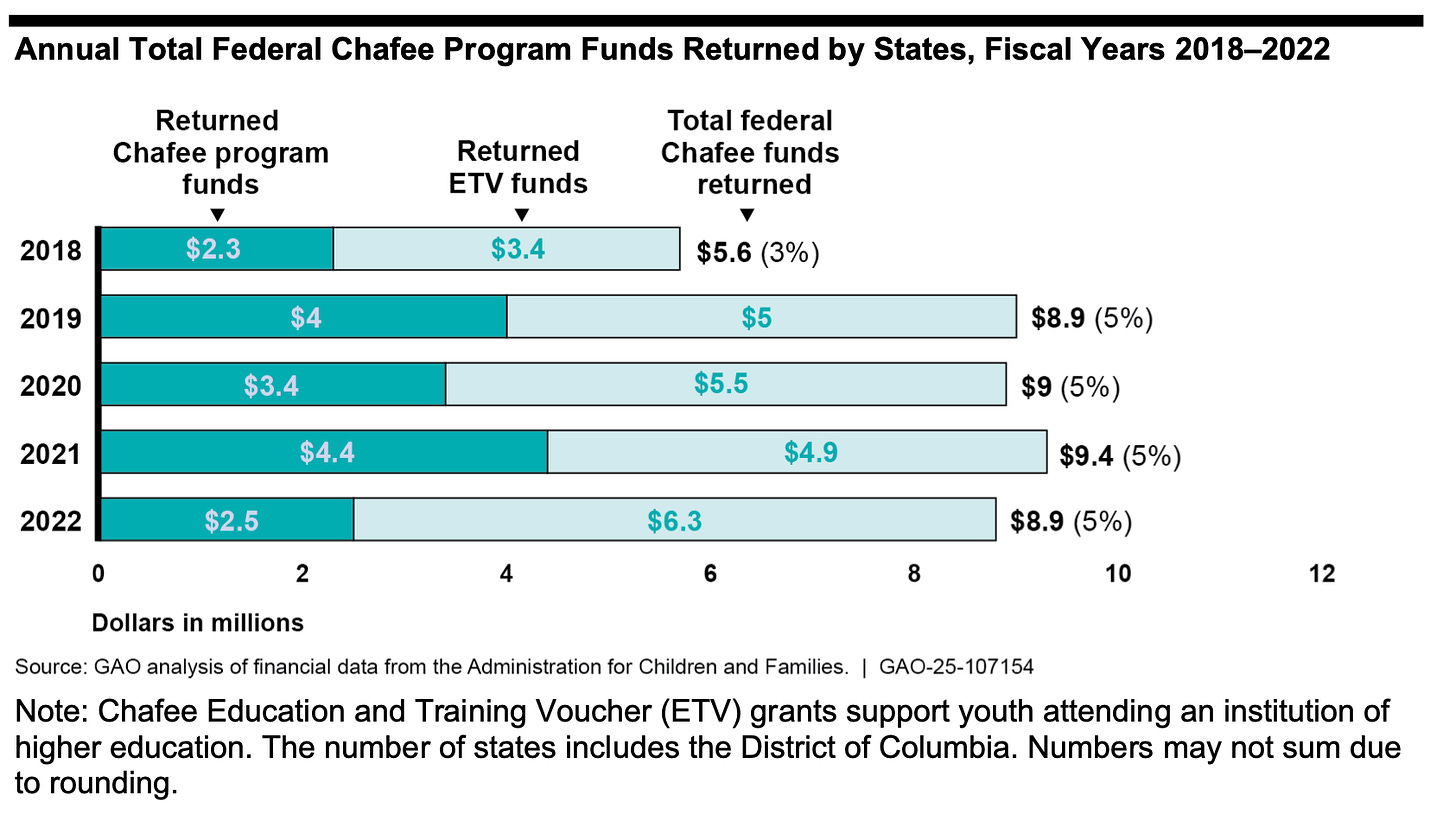When a Wonk Sees His Shadow
Get Your "Phil" of Updates on Executive Actions, Family First, & A GAO Report
Welcome, Wonks! Happy Belated Groundhog Day and shoutout to the best/only movie about it.
This week we look at executive actions, Family First, and a new report on older youth.
Executive Actions and Child Welfare
Look, Child Welfare Wonk does not break the news. We find it broken and put it back together.
Freezing (& Defrosting) Federal Spending
This was not a week in which anybody needed their boss to ask them “did you see the memo about this?”
Slated to take effect at 5PM on January 29th, this directive would have frozen much federal spending, and I suspect was very much on your radar.
The full extent of impacted programs is still unclear (despite a Q&A document), both because of how it’s written and because a federal judge blocked the freeze moments before it would have taken effect, after which OMB rescinded the memo.
There are two reasons to care: 1) this would have affected many child welfare programs, and 2) it’s possible OMB could revive a scaled back version.
Part of this exercise was a request for agencies to report to OMB on particular programs and spending obligations. Wonks estimate the memo would have frozen:
Title IV-E and IV-B funding;
Temporary Assistance for Needy Families;
Child Abuse Prevention and Treatment Act Funding (Titles I and II);
Social Services Block Grant; and
Medicaid (and more).
The other wrinkle is that the White House has indicated that the rescission is of OMB M-25-13 specifically.
That means the underlying spending freezes and reviews outlined in President Trump’s recent Executive Orders remain. Confused? You’re not alone.
Let’s dig in on what those are and what they mean for child welfare.
Recent Executive Actions & Child Welfare Implications
Establishing and Implementing the President’s “Department of Government Efficiency” (DOGE)
Overview:
DOGE is within government instead of the original plan to be an advisory committee to government.
Originally focused on software, DOGE’s ambit is clearly evolving with the news over the weekend about accessing Treasury’s payment systems.
Child Welfare Implications
Child welfare policy involves significant transfers of funding.
Multiple agencies can be involved in data reporting and analysis, and interoperability challenges can preclude coordination of care.
Regulatory Freeze Pending Review
Overview:
Agencies can’t put out or implement new rules.
Child Welfare Implications:
No major child welfare rules were at this stage.
This order limits Child Welfare Policy Manual guidance and clarification.
Initial Rescissions of Harmful Executive Orders and Actions
Overview:
Rescinds 78 EOs and presidential memoranda, on topics as wide-ranging as DEI, regulatory modernization, and Medicaid.
Child Welfare Implications
Potential rescissions:
The April, 2024 Final Rule Designated Placement Requirements Under Titles IV-E and IV-B for LGBTQI+ Children,
The September, 2023 Final Rule Separate Licensing or Approval Standards for Relative or Kinship Foster Family Homes
New possible policy
A revival of the 2019 waiver that did not apply nondiscrimination protections to a faith-based foster care agency.
Overview:
No hiring other than political appointees, until OMB has a plan to cut the federal workforce.
Child Welfare Implications:
Don’t expect hiring for civil service roles at ACF and the Children’s Bureau.
Restoring Accountability to Policy-Influencing Positions Within the Federal Workforce
Overview:
Applying to “policy-influencing positions,” this order requires makes it easier to fire career civil servants who work in policy roles.
Child Welfare Implications:
We don’t yet know what roles would fit here for ACF, but could likely impact:
Policy development, like writing regs
Program oversight, like state plan reviews; and
Grant administration, like writing and reviewing funding opportunities.
Ending Illegal Discrimination and Restoring Merit-Based Opportunity
Overview:
Requires agencies to terminate DEI programs and policies.
Federal grantees and contractors cannot use DEI programming.
Child Welfare Implications:
Could affect many child welfare grantees and contractors.
These and many of the other recent executive orders will require subsequent regulatory action, including rulemaking, to fully have an effect.
Nominations & Personnel
So who is going to implement all of this policy??
Expect no news on ACF and CB until this week’s vote on RFK, Jr. for HHS Sec.
Last week he had confirmation hearings with the Senate Finance Committee (which actually votes), and the Senate Health, Education, Labor, and Pensions (HELP) Committee (which doesn’t vote but has a courtesy hearing).
Finance Ranking Member Ron Wyden (D-OR) included 13 Questions for the Record on child welfare.
You can see all of the child welfare responses,1 which included:
Endorsement of kinship care as “the next best option compared to a foster youth’s safe reunification with their biological parents”
Commitments to oversight of congregate care and protecting children “from predators”, & implementing IV-B reauthorization.
Stating safe and appropriate foster care “will not involve the federal government supporting, promoting, or inculcating gender ideology”
Are you or someone you know entering or considering a child welfare role in the Administration? Drop me a line!
Weekly Wonky Deep Dive: Family First Edition
Last week we talked about Title IV-E of the Social Security Act, which matters because it’s 57%2 of federal child welfare spending, or $9.5 billion.3
This week, we are digging into Family First, a HUGE change to IV-E any child welfare wonk needs to know cold.
First, what is Family First? The 2018 Family First Prevention Services Act (AKA Family First AKA FFPSA, P.L. 115-123) is a bipartisan game changer for federal financing.
At its core, Family First is about three things:
Prevention. Well duh, Laris, it’s in the name! Yes, but this is the first permanent commitment of open-ended federal funds for it.
Kinship Care. The “Family First” part of the name isn’t just for keeping families together, but also to underscore the emphasis on placement with relatives.
Reducing and Reforming “Congregate Care”. The “Family First” name indeed has many layers, because it also refers to prioritizing family over institutions.
If you know nothing else, these are the three.
Prevention
Before Family First, a common refrain was “we have a 7 to 1 spending mismatch in child welfare”; for each $1 we spend on preventing foster care, we spend $7 on care.4
IV-E prevention pre-Family First was primarily of two limited flavors:
Title IV-E Waivers (Expired)
1994-2019, ~ half of states got cost-neutral waivers for flexibility/less eligibility paperwork.
So-Called “Traditional Candidacy” (Still Available)
States and tribes can claim 50% match IV-E administrative dollars for services when an eligible child is a “candidate for foster care.”
You probably noticed both examples kept referring to eligibility, meaning we are back to discussing the Aid to Families with Dependent Children (AFDC) Lookback…
As a refresher, Title IV-E foster care maintenance payments, administrative funds, and guardianship assistance are open-ended federal funds, with a catch.
To be eligible for federal funding, a child must have been removed from a family that would meet the 1996 AFDC income requirements without adjusting for inflation.
Family First changes that:
States and tribes get the option to establish a IV-E prevention program as of 10/1/19:
The Children’s Bureau maintains an ongoing list of IV-E prevention plans.
Services are for children at imminent risk of foster care and parents/caregivers;
Services must meet evidentiary requirements5 and be in one of three categories:
Mental health;
Substance use;
In-home parent skill-based services.
Participating states receive 50% reimbursement until FY 2027, then Federal Medical Assistance Percentage (FMAP);6
Unlike other aspects of IV-E, THERE IS NO AFDC LINK
Family First Kinship
A major challenge for kin caregivers is resources. Relative caregivers are often older, have lower incomes, and were not planning to be raising a child.
Navigator programs help kin caregivers find and access supports like health services, durable goods for children, legal assistance, or income security programs.
These programs existed before Family First, but it expanded them:
States and tribes can use kinship navigator programs that are in the Title IV-E Clearinghouse
Participating states receive 50% reimbursement until FY 2027, and then Federal Medical Assistance Percentage (FMAP);
These services must be coordinated with state or local service coordination efforts and planned with input from kinship caregivers and families
Again, THERE IS NO AFDC LINK
Congregate Care
The lead up to Family First also included a major emphasis on the harms of low quality institutional placements, and the benefits of appropriate high-quality treatment.
A 2015 Children’s Bureau report looked at congregate care data, finding nearly a third of children in congregate care were age 12 and under, and almost 30 percent didn’t have a treatment need to be there.
Family First created new standards for non-family settings:
States could delay these rules until October 1, 2021.
States and tribes can receive up to two weeks for any non-family placement;
After two weeks, only “specialized settings” are eligible:
Programs for pregnant and parenting youth;
Family-based residential substance use disorder treatment;
Programs for youth who have been or are at-risk for sex trafficking;
Independent Living; and
Qualified Residential Treatment Programs (QRTPs).
The big new one, meant to ensure treatment quality and appropriateness.
You can learn more about the congregate care reforms and QRTP from this American Academy of Pediatrics report and an article in Pediatrics on it7.
Wonk Out and Go Deeper:
Report Worth Reading
Okay Wonks, this week’s new report to read comes in response to a request from U.S. Senate Judiciary Committee Chairman Chuck Grassley (R-IA).
What it is: A Government Accountability Office (GAO, the nonpartisan office that studies policy issues for Congress) report on the Chafee Program.
Wait, What Was Chafee Again? Funded through Title IV-E of the Social Security Act, this program supports older youth in foster care and in transition to adulthood.
What Did the Report Look At? How states use these funds to support older youth.
What Did GAO Find? States are returning $8.4 million per year that they can’t spend.
Barriers include:
Invoicing delays;
Staff turnover;
Procurement challenges; and
Other administrative barriers and inefficiencies.
What GAO Recommends. ACF regional offices should help address these barriers.
Go Deeper. Read the report .
Have a good week, Wonks!
See page 20 for child welfare in full
You can see the most recent ChildTrends IV-E resource here, derived from the overall Child Welfare Financing Survey.
The Children’s Bureau regularly updates and disseminates spending data for 8 fiscal quarters at a time. The most recent is here.
See the Title IV-E Prevention Services Clearinghouse for more. It could be its own whole deep dive!
Technically the reimbursement level for Medicaid, but often tied to other programs too. It ranges from 50 percent to 77 percent for states and Puerto Rico, and 83 percent for the U.S. Virgin Islands, Northern Mariana Islands, Guam, and American Samoa.
Full disclosure, I was the PI for this report and a co-author of the Pediatrics paper







this article is well written. please read my less fun take on expansion. :)